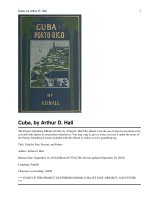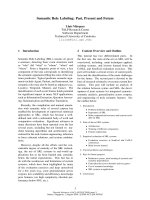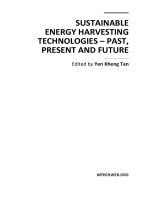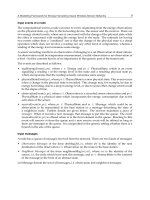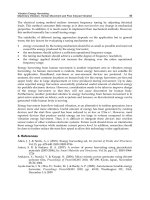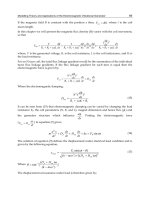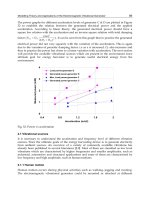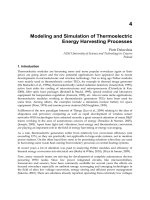Green analytical chemistry past, present and perspectives
Bạn đang xem bản rút gọn của tài liệu. Xem và tải ngay bản đầy đủ của tài liệu tại đây (13.09 MB, 460 trang )
Green Chemistry and Sustainable Technology
Justyna Płotka-Wasylka
Jacek Namieśnik Editors
Green Analytical
Chemistry
Past, Present and Perspectives
Green Chemistry and Sustainable Technology
Series Editors
Liang-Nian He
State Key Lab of Elemento-Organic Chemistry, Nankai University, Tianjin,
China
Robin D. Rogers
Department of Chemistry, The University of Alabama, Tuscaloosa, USA
Dangsheng Su
Dalian Institute of Chemical Physics, Chinese Academy of Sciences, Dalian, China
Pietro Tundo
Department of Environmental Sciences, Informatics and Statistics, Ca’ Foscari
University of Venice, Venice, Italy
Z. Conrad Zhang
Dalian Institute of Chemical Physics, Chinese Academy of Sciences, Dalian,
China
The series Green Chemistry and Sustainable Technology aims to present
cutting-edge research and important advances in green chemistry, green chemical
engineering and sustainable industrial technology. The scope of coverage includes
(but is not limited to):
– Environmentally benign chemical synthesis and processes (green catalysis,
green solvents and reagents, atom-economy synthetic methods etc.)
– Green chemicals and energy produced from renewable resources (biomass,
carbon dioxide etc.)
– Novel materials and technologies for energy production and storage (bio-fuels
and bioenergies, hydrogen, fuel cells, solar cells, lithium-ion batteries etc.)
– Green chemical engineering processes (process integration, materials diversity,
energy saving, waste minimization, efficient separation processes etc.)
– Green technologies for environmental sustainability (carbon dioxide capture,
waste and harmful chemicals treatment, pollution prevention, environmental
redemption etc.)
The series Green Chemistry and Sustainable Technology is intended to provide an
accessible reference resource for postgraduate students, academic researchers and
industrial professionals who are interested in green chemistry and technologies for
sustainable development.
More information about this series at />
Justyna Płotka-Wasylka Jacek Namieśnik
•
Editors
Green Analytical Chemistry
Past, Present and Perspectives
123
Editors
Justyna Płotka-Wasylka
Department of Analytical Chemistry
Gdańsk University of Technology
Gdańsk, Poland
Jacek Namieśnik (Deceased)
Department of Analytical Chemistry
Gdańsk University of Technology
Gdańsk, Poland
ISSN 2196-6982
ISSN 2196-6990 (electronic)
Green Chemistry and Sustainable Technology
ISBN 978-981-13-9104-0
ISBN 978-981-13-9105-7 (eBook)
/>© Springer Nature Singapore Pte Ltd. 2019
This work is subject to copyright. All rights are reserved by the Publisher, whether the whole or part
of the material is concerned, specifically the rights of translation, reprinting, reuse of illustrations,
recitation, broadcasting, reproduction on microfilms or in any other physical way, and transmission
or information storage and retrieval, electronic adaptation, computer software, or by similar or dissimilar
methodology now known or hereafter developed.
The use of general descriptive names, registered names, trademarks, service marks, etc. in this
publication does not imply, even in the absence of a specific statement, that such names are exempt from
the relevant protective laws and regulations and therefore free for general use.
The publisher, the authors and the editors are safe to assume that the advice and information in this
book are believed to be true and accurate at the date of publication. Neither the publisher nor the
authors or the editors give a warranty, expressed or implied, with respect to the material contained
herein or for any errors or omissions that may have been made. The publisher remains neutral with regard
to jurisdictional claims in published maps and institutional affiliations.
This Springer imprint is published by the registered company Springer Nature Singapore Pte Ltd.
The registered company address is: 152 Beach Road, #21-01/04 Gateway East, Singapore 189721,
Singapore
This book is dedicated in honour and memory
of Prof. Jacek Namieśnik (10 December
1949–14 April 2019), a visionary analytical
chemistry leader and a mentor to so many.
You will be missed.
Preface
Care about global climate change, pollution of environment and hazards to human
health have increased significantly. These fears have led to a call for changes in the
field of chemistry science and chemists’ action including those that are connected
with chemical analysis. Analytical chemistry is a central science that provides the
evolution in other chemical fields. There is no doubt analytical laboratories have an
essential role to play in environmental protection through monitoring of pollutants
in air, water or soil. On the other hand, analytical activities involve the use of many
reagents and solvents, thus generating toxic residues. For these reasons, Green
Analytical Chemistry (GAC) was introduced in 2000 to reduce or remove the side
effects of analytical practices on operators and the environment.
This idea has attracted a great deal of interest among chemists, particularly those
concerned with making laboratory practices in analytical chemistry environmentally friendly. As it is a great challenge to reach an acceptable compromise between
increasing the quality of results and improving environmental friendliness of analytical methods, it is important to follow the guidelines and principles of Green
Analytical Chemistry which have been introduced, and provide a framework for
GAC.
All this makes the appearing field of Green Analytical Chemistry a “hot topic”
not only in academia but also in industrial and governmental laboratories. This
book starts by introducing the history of Green Analytical Chemistry as well as
laws and principles that are based on the GAC ideology. Another important issue
that will determine the future of Green Analytical Chemistry is education of this
concept in the society; thus, the subject connecting with teaching of GAC based on
several examples is also discussed. It then goes on to present the trends and future
perspectives of the analytical laboratories. Developments and new achievements in
such fields as direct techniques of detection and determination of trace analytes,
extraction of trace constituents, and nature of the derivatization process and green
chromatographic techniques are widely discussed. Flow injection analysis towards
Green Analytical Chemistry as well as remote monitoring of environmental pollutants is presented. The book also contains chapters which are focused on the smart
vii
viii
Preface
sorption materials and new types of solvents used in the field of analytical
chemistry.
As the greenness of analytical procedure is multivariable aspect, many greenness
criteria should be taken into consideration. From the other side, modern analytical
chemistry offers dozens of analytical methodologies, based on different methods
and techniques, which are used for determination of analytes in a given matrix. Due
to such complex decision-making processes, multi-criteria decision analysis tools
are applied as systematic approach to deal with complex decisions. In this book, the
reader will find the description of step-by-step approach to application of three
multi-criteria decision analysis tools as Green Analytical Chemistry systems. In
addition, several tools that can be applied to evaluate the developed analytical
procedures are presented.
The book concludes with a discussion of how GAC is both possible and necessary. The final chapter summarizes contemporary problems and gives future
perspectives of Green Analytical Chemistry. Green Analytical Chemistry is aimed
at managers of analytical laboratories but will also interest teachers of analytical
chemistry and green public policy-makers.
This book aims to celebrate the advancements in Green Analytical Chemistry,
which encompasses all measurement techniques for all types of applications that
minimize or eliminate the generation of chemical waste. We believe that this book
will allow the reader to identify that GAC can operate in all contexts, not only in
environmental application but also in the industrial and the sanitary. We hope that
this book contributes to move from the theory to the practice; therefore, editors and
authors are convinced of the necessity of this book.
We would like to express our thanks to the personnel of Springer who have
offered all the time their support, especially June Tang and Sunny Guo for their help
to make this book possible. The generosity, patience and good work of all the
authors are acknowledged. We are convinced that this book is the starting point for
future cooperation in a new analytical chemistry.
Gdańsk, Poland
Justyna Płotka-Wasylka
Contents
1
History and Milestones of Green Analytical Chemistry . . . . . . . . .
Justyna Płotka-Wasylka, Magdalena Fabjanowicz, Kaja Kalinowska
and Jacek Namieśnik
2
Teaching Green Analytical Chemistry on the Example
of Bioindication and Biomonitoring (B & B) Technologies . . . . . . .
Bernd Markert, Eun-Shik Kim, Stefan Fränzle, Simone Wünschmann,
Meie Wang, Rumy Djingova, Mira Aničić Urošević, Shirong Liu,
John Hillman, Jean-Bernard Diatta, Susanta Lahiri, Ivan Suchara,
Piotr Szefer, Guntis Tabors, Jörg Rinklebe, Stefano Loppi,
Harry Harmens, Peter Hooda, Maria Wacławek, Filipe Tack,
Svetlana Gorelova, Anna Knox, Józef Pacyna, Elias Baydoun,
Marina Frontasyeva, Adnan Badran, Alexander Lux,
Silvia De Marco, Erik Meers, Andrzej Kłos and Jerome Nriagu
3
Teaching Green Analytical and Synthesis Chemistry:
Performing Laboratory Experiments in a Greener Way . . . . . . . . .
Arabinda Kumar Das, Ruma Chakraborty and Miguel de la Guardia
1
19
45
75
4
Mass Spectrometry-Based Direct Analytical Techniques . . . . . . . . .
Renata Marcinkowska, Klaudia Pytel and Bożena Zabiegała
5
New Achievements in the Field of Extraction of Trace Analytes
from Samples Characterized by Complex Composition
of the Matrix . . . . . . . . . . . . . . . . . . . . . . . . . . . . . . . . . . . . . . . . . . 103
Katarzyna Owczarek, Natalia Szczepańska, Justyna Płotka-Wasylka
and Jacek Namieśnik
6
Greening the Derivatization Step in Analytical Extractions:
Recent Strategies and Future Directions . . . . . . . . . . . . . . . . . . . . . 151
Muhammad Sajid
ix
x
Contents
7
Smart Sorption Materials in Green Analytical Chemistry . . . . . . . . 167
Francesc A. Esteve-Turrillas, Sergio Armenta, Salvador Garrigues
and Miguel de la Guardia
8
Ionic Liquids and Deep Eutectic Solvents in the Field
of Environmental Monitoring . . . . . . . . . . . . . . . . . . . . . . . . . . . . . 203
Inês S. Cardoso, Augusto Q. Pedro, Armando J. D. Silvestre
and Mara G. Freire
9
Green Chromatography and Related Techniques . . . . . . . . . . . . . . 241
Alshymaa A. Aly and Tadeusz Górecki
10 Flow Injection Analysis Toward Green Analytical Chemistry . . . . . 299
Anita Martinović Bevanda, Stanislava Talić and Anita Ivanković
11 Remote Monitoring of Environmental Pollutants . . . . . . . . . . . . . . 325
Jacek Gębicki and Bartosz Szulczyński
12 Comparative Greenness Evaluation . . . . . . . . . . . . . . . . . . . . . . . . 353
Marta Bystrzanowska, Aleksander Orłowski and Marek Tobiszewski
13 Quantitative Assessment . . . . . . . . . . . . . . . . . . . . . . . . . . . . . . . . . 379
Piotr Konieczka and Małgorzata Rutkowska
14 QuEChERS—A Green Alternative Approach
for the Determination of Pharmaceuticals and Personal Care
Products in Environmental and Food Samples . . . . . . . . . . . . . . . . 395
Christina Nannou, Anna Ofrydopoulou, David Heath, Ester Heath
and Dimitra Lambropoulou
15 Green Analytical Chemistry: Summary of Existing Knowledge
and Future Trends . . . . . . . . . . . . . . . . . . . . . . . . . . . . . . . . . . . . . 431
Justyna Płotka-Wasylka, Agnieszka Gałuszka and Jacek Namieśnik
Contributors
Alshymaa A. Aly Department of Chemistry, University of Waterloo, Waterloo,
Canada;
Department of Analytical Chemistry, Faculty of Pharmacy, Minia University,
Minya, Egypt
Mira Aničić Urošević Institute of Physics Belgrade, University of Belgrade,
Belgrade, Serbia
Sergio Armenta Department of Analytical Chemistry, University of Valencia,
Valencia, Spain
Adnan Badran Arab Academy of Sciences, Beirut, Lebanon
Elias Baydoun Department of Biology, American University of Beirut, Beirut,
Lebanon
Anita Martinović Bevanda Department of Chemistry, Faculty of Science and
Education, University of Mostar, Mostar, Bosnia and Herzegovina
Marta Bystrzanowska Department of Analytical Chemistry, Chemical Faculty,
Gdańsk University of Technology (GUT), Gdańsk, Poland
Inês S. Cardoso CICECO—Aveiro Institute of Materials, Chemistry Department,
University of Aveiro, Aveiro, Portugal
Ruma Chakraborty Department of Analytical Chemistry, University of Valencia,
Valencia, Spain
Arabinda Kumar Das Department of Analytical Chemistry, University of
Valencia, Valencia, Spain
Jean-Bernard Diatta Department of Agricultural Chemistry and Environmental
Biogeochemistry, Poznan University of Life Sciences, Poznań, Poland
Rumy Djingova Faculty of Chemistry, University of Sofia, Sofia, Bulgaria
xi
xii
Contributors
Francesc A. Esteve-Turrillas Department of Analytical Chemistry, University of
Valencia, Valencia, Spain
Magdalena Fabjanowicz Department of Analytical Chemistry, Faculty of
Chemistry, Gdańsk University of Technology, Gdańsk, Poland
Stefan Fränzle Department of Biological and Environmental Sciences, University
of Dresden, Zittau, Germany
Mara G. Freire CICECO—Aveiro Institute of Materials, Chemistry Department,
University of Aveiro, Aveiro, Portugal
Marina Frontasyeva Department of Neutron Activation Analysis, Joint Institute
for Nuclear Research, Dubna, Russia
Agnieszka Gałuszka Geochemistry and the Environment Div., Institute of
Chemistry, Jan Kochanowski University, Kielce, Poland
Salvador Garrigues Department of Analytical Chemistry, University of Valencia,
Valencia, Spain
Jacek Gębicki Department of Process Engineering and Chemical Technology,
Faculty of Chemistry, Gdańsk University of Technology, Gdańsk, Poland
Tadeusz Górecki Department of Chemistry, University of Waterloo, Waterloo,
Canada
Svetlana Gorelova Department of Biology, Natural Science Institute, Tula State
University, Tula, Russia
Miguel de la Guardia Department of Analytical Chemistry, University of
Valencia, Valencia, Spain
Harry Harmens Centre for Ecology and Hydrology, Environment Centre Wales,
Bangor, UK
David Heath Department of Environmental Sciences, Jožef Stefan Institute,
Ljubljana, Slovenia
Ester Heath Department of Environmental Sciences, Jožef Stefan Institute,
Ljubljana, Slovenia;
Jožef Stefan International Postgraduate School, Ljubljana, Slovenia
John Hillman James Hutton Institute, Invergowrie, UK
Peter Hooda School of Geography, Geology and the Environment, Kingston
University London, London, UK
Anita Ivanković Faculty of Agriculture and Food Technology, University of
Mostar, Mostar, Bosnia and Herzegovina
Kaja Kalinowska Department of Analytical Chemistry, Faculty of Chemistry,
Gdańsk University of Technology, Gdańsk, Poland
Contributors
xiii
Eun-Shik Kim Department of Forestry Environment and Systems, College of
Forest Science, Kookmin University, Seoul, South Korea
Andrzej Kłos Chair of Biotechnology and Molecular Biology, Opole University,
Opole, Poland
Anna Knox Department of Environmental Science and Biotechnology, Savannah
River National Laboratory, Aiken, USA
Piotr Konieczka Department of Analytical Chemistry, Faculty of Chemistry,
Gdańsk University of Technology, Gdańsk, Poland
Susanta Lahiri Department of Chemical Sciences Division, Saha Institute of
Nuclear Physics, Kolkata, India
Dimitra Lambropoulou Department of Chemistry, Aristotle University of
Thessaloniki, Thessaloniki, Greece
Shirong Liu Department of Forest Ecology and Hydrology, Chinese Academy of
Forestry, Beijing, People’s Republic of China
Stefano Loppi Department of Life Sciences, University of Siena, Siena, Italy
Alexander Lux Department of Plant Physiology, Comenius University Bratislava,
Bratislava, Slovakia
Renata Marcinkowska Department of Analytical Chemistry, Faculty of
Chemistry, Gdańsk University of Technology, Gdańsk, Poland
Silvia De Marco Department for Biology, Faculty of Exact and Natural Sciences,
Universidad Nacional de Mar del Plata, Mar del Plata, Argentina
Bernd Markert Environmental Institute of Scientific Networks, Haren-Erika,
Germany
Erik Meers Department of Green Chemistry and Technology, University of
Ghent, Ghent, Belgium
Jacek Namieśnik Department of Analytical Chemistry, Faculty of Chemistry,
Gdańsk University of Technology, Gdańsk, Poland
Christina Nannou Department of
Thessaloniki, Thessaloniki, Greece
Chemistry,
Aristotle
University
of
Jerome Nriagu School of Public Health, Center for Human Growth and
Development, University of Michigan, Ann Arbor, MI, USA
Anna Ofrydopoulou Department
Thessaloniki, Thessaloniki, Greece
of
Chemistry,
Aristotle
University
of
Aleksander Orłowski Department of Management, Faculty of Management and
Economics, Gdańsk University of Technology (GUT), Gdańsk, Poland
xiv
Contributors
Katarzyna Owczarek Department of Analytical Chemistry, Faculty of Chemistry,
Gdańsk University of Technology, Gdańsk, Poland
Józef Pacyna Department of Energy and Fuels, AGH University of Science and
Technology, Krakow, Poland
Augusto Q. Pedro CICECO—Aveiro Institute
Department, University of Aveiro, Aveiro, Portugal
of
Materials,
Chemistry
Justyna Płotka-Wasylka Department of Analytical Chemistry, Faculty of
Chemistry, Gdańsk University of Technology, Gdańsk, Poland
Klaudia Pytel Department of Analytical Chemistry, Faculty of Chemistry, Gdańsk
University of Technology, Gdańsk, Poland
Jörg Rinklebe Department of Soil- and Groundwater-Management, University of
Wuppertal, Wuppertal, Germany
Małgorzata Rutkowska Department of Analytical Chemistry, Faculty of
Chemistry, Gdańsk University of Technology, Gdańsk, Poland
Muhammad Sajid Center for Environment and Water, Research Institute, King
Fahd University of Petroleum and Minerals, Dhahran, Saudi Arabia
Armando J. D. Silvestre CICECO—Aveiro Institute of Materials, Chemistry
Department, University of Aveiro, Aveiro, Portugal
Ivan Suchara Silva Tarouca Research Institute for Landscape and Ornamental
Gardening, Průhonice, Czech Republic
Natalia Szczepańska Department of Analytical Chemistry, Faculty of Chemistry,
Gdańsk University of Technology, Gdańsk, Poland
Piotr Szefer Department of Food Sciences, Medical University of Gdansk,
Gdansk, Poland
Bartosz Szulczyński Department of Process Engineering and Chemical
Technology, Faculty of Chemistry, Gdańsk University of Technology, Gdańsk,
Poland
Guntis Tabors Faculty of Biology, University of Latvia, Riga, Latvia
Filipe Tack Department of Applied Analytical and Physical Chemistry, Ghent
University, Ghent, Belgium
Stanislava Talić Department of Chemistry, Faculty of Science and Education,
University of Mostar, Mostar, Bosnia and Herzegovina
Marek Tobiszewski Department of Analytical Chemistry, Chemical Faculty,
Gdańsk University of Technology (GUT), Gdańsk, Poland
Maria Wacławek Department of Biotechnology and Molecular Biology, Opole
University, Opole, Poland
Contributors
xv
Meie Wang Research Center for Eco-Environmental Sciences, Chinese Academy
of Sciences, Beijing, China
Simone Wünschmann Environmental
Haren-Erika, Germany
Institute
of
Scientific
Networks,
Bożena Zabiegała Department of Analytical Chemistry, Faculty of Chemistry,
Gdańsk University of Technology, Gdańsk, Poland
Chapter 1
History and Milestones of Green
Analytical Chemistry
Justyna Płotka-Wasylka, Magdalena Fabjanowicz, Kaja Kalinowska
and Jacek Namie´snik
Abstract Due to the increased environmental consciousness, Green Analytical
Chemistry (GAC) is an important concept steadily gaining popularity, as its implementation facilitates the decrease the detrimental effect analytical chemistry methodologies may have on the environment. In this chapter, a brief overview of the history
of Green Analytical Chemistry (GAC) and its milestone was given. Emphasis has
been put on the beginnings of green chemistry awareness and on the possibilities
of increasing and evaluating the greenness of both currently used and designed analytical chemistry methodologies. In addition, the prospects of implementation of 12
principles of Green Analytical Chemistry have been briefly described.
1.1 Introduction
Concern and interest for the state of the environment are constantly increasing;
therefore, it becomes significant to examine those chemists and chemical engineers’
activities which may impact on the environment state, on both the laboratory and
the industrial scales [1]. Introduction of the green chemistry idea is associated with
the dissemination of the principles of sustainable development and the highly visible tendency to the implementation of these principles in laboratories and chemical
plant. In fact, principles of green chemistry have been adopted in the specific fields
of chemistry. However, in the literature, it can be observed that before the popularization of the green chemistry concept, there was a consciousness among analytical
chemists of the need to develop sustainable methodologies, in order to save solvents
and reagents, as well as to replace the most toxic solvents by other innocuous or
less toxic ones [2]. The adverse effects of the application of analytical procedures
may commit damage to the environment and serious risks for operators; therefore,
for these reasons, it is essential to think about the effects as well as consequences
J. Płotka-Wasylka · M. Fabjanowicz (B) · K. Kalinowska · J. Namie´snik
Department of Analytical Chemistry, Faculty of Chemistry, Gda´nsk University of Technology,
11/12 G. Narutowicza Street, 80-233 Gda´nsk, Poland
e-mail:
© Springer Nature Singapore Pte Ltd. 2019
J. Płotka-Wasylka and J. Namie´snik (eds.), Green Analytical Chemistry,
Green Chemistry and Sustainable Technology,
/>
1
2
J. Płotka-Wasylka et al.
of action as researchers/users of analytical methods. Hence, from the viewpoint of
people who take care of the environment and themselves as well as part of economic aspects of analytical methodologies, the special attention should be paid on
the inherent risk of some samples type, aliquot of reagents and solvents used, the
consumption of energy related to more and more modern instrumentation and, without a doubt, produced laboratory wasted and emissions coming from the numerous
steps of analytical methodologies [3].
In this chapter, we will shortly describe the history and milestones of Green Analytical Chemistry (GAC). In addition, the facts which made possible the tremendous
interest in Green Analytical Chemistry exist today, and the origin of many of terms
is currently used.
1.2 The Birth of the Concept of Green Analytical
Chemistry
Nowadays, GAC is the concept which every chemist analyst should know. Therefore,
it is not surprising that analytical chemistry studies in the frame of chemistry degrees
around the world have evolved in different ways. However, a responsibility among the
analytical chemists’ society appeared long before the introduction of the GAC term.
Many innovative advances in the area of sample preparation, measurement as well
as data handling associated with microwave-assisted flow injection analysis (FIA),
sample digestion and extraction (MAE), and chemometrics were represented in the
middle of the 1970s. It needs to be noted that the methodological milestones (Fig. 1.1)
which were invented to increase the green character of the analytical protocols were
mainly reached before the formulation of GAC idea [2]. An essential step on the way
to introduce the GAC idea was concept developed in 1993 regarding the possibility
offered by the combination of the processes of photo-assisted degradation linked to
FIA manifolds carried out in the spectrometric determination of phenolic compounds
[2]. Another important idea was the application of the term “clean waste” instead
of word “waste”, suggesting an alternative method which includes an additional
chemical effort to reduce the environmental impact of FIA determinations. That was
the beginning of the clean analytical chemistry concept. In 1995, the potentiality
proposed by the degradation processes’ contribution and FIA to enhance analytical
methods was confirmed.
In the same year, the article entitled “Towards environmentally conscientious
Analytical Chemistry through miniaturization containment and reagent replacement”
was published, and it is obvious that this was the first declaration of the principles
of what is today called Green Analytical Chemistry [4]. In another manuscript [5], a
term “waste minimization” was proposed and recommended to analytical practice.
Although the term Green Analytical Chemistry was not applied in this manuscript,
1 History and Milestones of Green Analytical Chemistry
Fig. 1.1 Milestones of Green Analytical Chemistry
3
4
J. Płotka-Wasylka et al.
Fig. 1.2 Basic ideas for an integrated eco-friendly approach of Analytical Chemistry
it is allotted as the precursor works of GAC because the green idea was inherently
present. Since this time, green idea development in analytical practice was going
very quickly. Thus, more and more improvements, in both procedures and instrumentations, were developed and introduced what can be seen in Fig. 1.1. Moreover,
the basic ideas for an integrated environmentally friendly approach of analytical
chemistry were pointed out (Fig. 1.2).
In 1973, an important work entitled “Trends in the Teaching of Analytical Chemistry in American Universities” was published. In this work, a well-known sentence
“the usual approach to predict the future is to project past trends” has been cited
[6], showing that scientific activities must be adapted to societal needs in order to
surmount any crises by a correct projection of the past to the future, making adequate
behavioural changes to avoid errors made in the past and to incorporate new ideas into
old practices [2]. This idea was extended in 1987 at the Euroanalysis VI Conference,
under the title “Changes of paradigms in Analytical Chemistry”. In this presentation,
1 History and Milestones of Green Analytical Chemistry
5
Fig. 1.3 Steps of the analytical process to be considered in the frame of the Ecological Paradigm
the term paradigm was used not only as a pattern and a syntax-like scheme but also as
a guide for new friends in our academic society to give them novel tools for solving
problems and a new platform for discussion and communication [2, 7]. In addition,
six successive paradigms in the evolution of Analytical Chemistry—from archeochemistry to alchemy, iatrochemistry, chemiology, chemiurgy and finally ecological
chemistry—were identified. In this presentation, it has been presented that Analytical Chemistry today must be closely associated with environmental protection. In
addition, all analytical activities must consider the different aspects connected to the
preservation of our ecosystem. Therefore, we must be conscious that in our professional activity, it is required to take care of the operator’s safety and the environment
preservation. Although there is no clear transition between the archaeological period
and the different paradigms, nowadays the ecological mentality must inform the work
of the analyst and relationship with society. Thus, taking into account the analytical
process, the attention should be paid not only to the problems, samples and data to
be obtained, but also to the nature and amounts of the reagents to be applied, the
emissions and wastes generated during the whole process, the energy requirements
and the risks to operators and the environment [2, 7]. Steps of the analytical process
to be considered in the frame of the Ecological Paradigm are presented in Fig. 1.3.
Without a doubt, the analytical activity increase on the environmental samples and
on the undesirable environmental constituents had the knock-on effect of increasing
the number of analytical wastes and provided notable changes in the laboratories’
mentality about the impact of their residues. Evolution of the ecological mentality
within analytical laboratories is very visible (Fig. 1.4), and it is a consequence of
the bad conscience about the side effects of the increase of reagent consumption
and waste generation. This is hard evidence that the new opportunities proposed by
chemistry at the end of the last century were closely associated with the ecological mentality, and here, the idea of GAC offered excellent opportunities from the
academic as well as business points of view.
6
J. Płotka-Wasylka et al.
Fig. 1.4 Steps of the evolution of the ecological mentality within analytical laboratories
1.3 The Evaluation of Methodologies from Traditional
Analytical Chemistry to Green Analytical Chemistry
In the 1990s, Paul Anastas edited a series of texts concerning the need for the movement towards environmentally benign chemistry, about Green Analytical Chemistry
and its importance in the frame of green chemistry [2]. In particular, Anastas emphasized its twofold role in the environmental protection, caused by the fact that various
analytical chemistry methodologies could not only contribute themselves to detection of potentially undesirable environmental constituents but possibly also take part
in the increase of pollution’s amount and further ecological problems. Because of
that it is important to work on greening the analytical methods, while taking their
accuracy, sensitivity and precision under consideration.
1.3.1 Principles of Green Analytical Chemistry
In 1998, Anastas and Warner created the 12 principles of green chemistry [8]. However, since they were coined in order to be applied in the field of synthetic chemistry,
only some of them could be employed to the analytical chemistry. Because of that
there was a need to adapt the rules in a way that would make their implementation
1 History and Milestones of Green Analytical Chemistry
7
Fig. 1.5 Goals of the Green
Analytical Chemistry
in the field of analytical chemistry possible. Thus, 12 undermentioned principles of
Green Analytical Chemistry have been designed [9]:
1.
2.
3.
4.
5.
6.
7.
8.
9.
10.
11.
12.
If possible, sample treatment should be avoided by the use of direct methods.
The number and size of the samples should be as small as possible.
Measurement should be performed in situ.
Processes and operations should be integrated.
If possible, automation and miniaturization of analytical methods should be
selected.
Derivatization should be avoided.
The number of wastes generated should be as little as possible, and it should be
managed accordingly.
Multi-analyte and multi-parameter methods should be applied wherever it is
possible.
Use of the energy should be minimal.
Reagents from renewable sources should be preferred.
Toxic reagents and solvents should be eliminated or replaced.
Safety of the operators should be improved.
Based on the principles of both green chemistry and Green Analytical Chemistry,
four points have been designated as top priorities (Fig. 1.5), since their implementation would be a significant step in greening analytical methods [1].
8
J. Płotka-Wasylka et al.
Fig. 1.6 Types of factors
evaluated during greenness
assessment
1.3.2 Clean Analytical Methods
The first descriptions of clean analytical method appeared in 1995 [10]. This term
has been coined in order to speak about methods in which additional effort was
made in order to decrease the negative impact the analysis has on the environment,
such as detoxification of wastes or recovery of the catalysts [2]. Based on the all
aforementioned priorities and principles of GAC, an ideally clean analytical method
would be direct, nondestructive, reagentless procedure that requires only a minimal
energy, while at the same time is also fast and capable multiple parameters and
analytes in a single run.
However, in case of many analytical problems, it is not possible to use a so-called
ideal method that would be in accordance with all principles of Green Analytical
Chemistry, since not many analytes and parameters can be determined simultaneously
or from an untreated sample. Because of that, it is important to evaluate all aspects of
analytical methods that affect their sustainability and that may be improved without
affecting their basic analytical characteristics.
In order to minimize the negative environmental impact of already existing methods, each step of analytical procedure (i.e. sampling collection, sampling preparation,
analysis and the evaluation of the results) should be evaluated based on their influence on the environment and the possibility of increasing their greenness [11]. Four
main categories of factors taken under consideration are depicted in Fig. 1.6 [12].
Characteristics of reagents and solvents used in the analytical process are one of
the key factors affecting its greenness, since they may be detrimental to the environment, as well as human health and safety. On many occasions, these compounds are
flammable, toxic or otherwise potentially harmful to the biota. Moreover, the use of
the nongreen reagents at each step of analytical methodology may result in the neces-
1 History and Milestones of Green Analytical Chemistry
9
sity of the implementation of expensive and time-consuming waste treatment [13].
Due to the aforementioned reasons, one of the aims of Green Analytical Chemistry
is to identify reagents to be replaced and substitute them with nontoxic, harmless
alternatives [14].
Out of all steps of the analytical procedure, samples’ preparation is usually the
most polluting part, since techniques such as extraction or mineralization are often
energy-consuming and require the use of various nongreen solvents. Because of
that the greenest approach would be to use direct analytical methods, in which the
whole step of sample preparation is negligible. However, in many cases, isolation and
preconcentration of analytes are unavoidable and direct analysis cannot be performed.
Thus, the emphasis should be put on the automation and miniaturization of the
process, as well as the use of the least harmful compounds and novel techniques
that require much smaller amounts of organic solvent. Reduction and, if possible,
elimination of the use of a nongreen solvent in samples preparation should be a
priority not only due to being detrimental to the environment but also because it
could potentially reduce the cost of the analysis [11].
Samples’ collection is usually not associated with being harmful to the ecosystem;
nevertheless, transportation, storage and the collection itself involve money, material
and energy. Moreover, in the case of environmental or biological samples whose
physical or chemical composition changes during storage. Notwithstanding, in the
case of the measurements that can be performed directly in the flow system, it is
recommended to avoid the sample collection step by using greener in-line system
instead of off-line mode [15].
When neither in-line analysis nor direct methods can be used, the emphasis should
be put on choosing the greenest approach. The factors such as the amount of waste
generated and energy used, as well as the occupational hazard of using the instrument
in question, should be taken under consideration.
1.3.3 Green Analytical Evaluation Tools
Since analytical procedures are usually complex and consist of several steps, it might
be difficult to assess the overall impact it has on the environment. Moreover, comparison of different methodologies based on their accordance with GAC principles
necessitates some form of greenness evaluation [16]. As a consequence, several
evaluation tools have been proposed in order to facilitate the evaluation of analytical
procedures.
National Environmental Methods Index (NEMI) is a tool in which the procedures
are assessed based on their greenness profiles. In order to evaluate a particular method,
four main criteria are taken under consideration: toxicity and corrosivity of used
chemicals, hazard and waste amount. The procedure in question is seen as green
when:
• the chemical used is not hazardous or listed as persistent, bioaccumulative or toxic,
• pH during the analysis is in the 2–12 range,
10
J. Płotka-Wasylka et al.
Fig. 1.7 Exemplary pictogram of NEMI
• the amount of waste generated is less than 50 g [17].
The results of the evaluation are presented in the form of the profile’s symbol
divided into four parts (Fig. 1.7), each one of them provides information about the
greenness of the method in relation to a different criterion. NEMI pictograms are
easy to read by potential users; however, its use is time-consuming since it requires
searching each of the used chemicals on various lists of harmful substances. Moreover, application of NEMI in comparison of different procedures may be difficult,
since it provides neither quantitative nor semi-quantitative information. Therefore, in
order to increase NEMI applicability in collating multiple analytical methodologies,
Guardia et al. proposed the use of a three-coloured scale in order to evaluate the
greenness of each aspect of the procedure [10].
Another tool has been proposed by Raynie and Driver [18]. In this case, analytical
procedures are evaluated based on five criteria: potential environmental, health and
safety risk, amount of generated waste and energy consumption. As can be seen in
Fig. 1.8, results are presented in a form of pictogram divided into five parts, each of
them marked green, yellow or red based on category’s environmental impact. With
the use of the visual representation of this tool, it is possible to compare two or more
different procedures based on their greenness.
An alternative approach is to use the Analytical Eco-Scale proposed by Namie´snik
et al. [19]. In this tool, various parameters of the procedure, such as the number of
reagents used or waste generated, are assessed. For each parameter that differs from
the principles of GAC, penalty points are assigned and then subtracted from 100.
Based on the obtained result, it is possible to evaluate greenness of the method in
question: the higher the final score is, the greener the suggested method is. Analytical
Eco-Scale can be used in order to evaluate new analytical methods, as well as to
compare them with already existing techniques since it enables quick assessment
and appraises many aspects of environmental impact in an efficient manner.
The newest tool is the Green Analytical Procedure Index (GAPI). In this approach,
greenness evaluation of each step of the analytical procedure is presented in a form
of pictogram comprised of five pentagrams that provide information on the greenness of different steps of the analytical procedure (Fig. 1.9). Sample collection and
